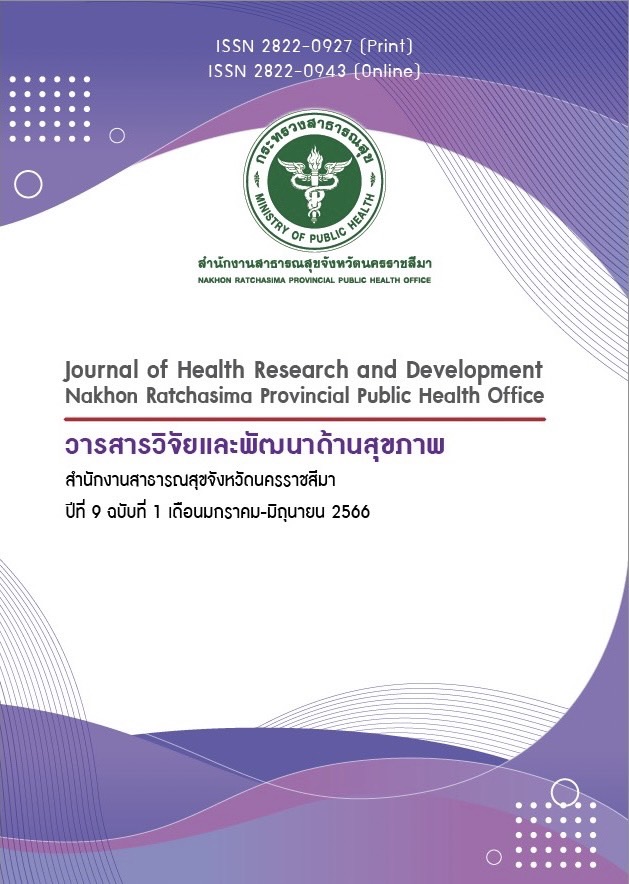Presenteeism
Keywords:
Presenteeism, healthcare workerAbstract
Behaviors at work can be indicative of a worker’s health. Presenteeism, a practice of being present at work while not fully functioning from illness, injury, or other medical conditions hence potential errors, compromised efficiency, and additional costs over frequent absence, is one of them. 40% of this particular behavior at workplace is found in general. The number increases to 45% among medical workers. The causes vary from illnesses, financial problems, nature of work, organizational culture, Key Performance Indicator, personal preferences, and the outbreak of COVID-19 that cause impacts on individual, social, and organizational levels. On the individual level, people suffer prolonged and more serious condition. On the social level, workplace relationships are disrupted. On the organization level, health coverage increases while productivity has declined. Occupational health approaches should be put in place, with the collaboration of business owners, supervisors, and those who look after the health of workers with the behavior and the risk of developing it, to find and develop primary, secondary, and tertiary prevention on it.
References
Johns GJJoob. Presenteeism in the workplace: A review and research agenda 2010; 31(4): 519 - 42.
Nagata T, Mori K, Ohtani M, Nagata M, Kajiki S, Fujino Y, et al. Total health-related costs due to absenteeism, presenteeism, and medical and pharmaceutical expenses in Japanese employers 2018; 60(5) : 273.
Hansen CD, Andersen JH. Going ill to work--what personal circumstances, attitudes and work-related factors are associated with sickness presenteeism? Social science & medicine 2008; 67(6): 956 – 64.
Eurofound. Health and Wellbeing at Work: A Report Based on the Fifth European Working Conditions Survey; 2012.
Turpin RS, Ozminkowski RJ, Sharda CE, Collins JJ, Berger ML, Billotti GM, et al. Reliability and validity of the Stanford Presenteeism Scale 2004; 1123 – 33.
Smithy DJJAoEHAIJ. Absenteeism and “presenteeism” in industry 1970; 21(5): 670 – 7.
Aronsson G, Gustafsson K, Dallner MJJoE, Health C. Sick but yet at work. An empirical study of sickness presenteeism 2000; 54(7): 502 – 9.
Koopman C, Pelletier KR, Murray JF, Sharda CE, Berger ML, Turpin RS, et al. Stanford presenteeism scale: health status and employee productivity; 2002.
Schultz AB, Edington DWJJoor. Employee health and presenteeism: a systematic review. 2007; 17(3): 547 – 79 .
Virtanen M, Kivimäki M, Elovainio M, Vahtera J, Ferrie JEJO, medicine e. From insecure to secure employment: changes in work, health, health related behaviours, and sickness absence. 2003; 60(12): 948 – 53.
Kinman G, Clements AJ, Hart JJTPJ. When are you coming back? Presenteeism in UK prison officers 2019; 99(3): 363 – 83.
Development CIoPa. CIPD Absence Management: Annual Survey Report; 2016
Miraglia M, Johns GJJoohp. Going to work ill: A meta-analysis of the correlates of presenteeism and a dual-path model 2016; 21(3): 261.
Schaufeli WB, Bakker AB, Van Rhenen WJJoOBTIJoI, Occupational, Psychology O, Behavior. How changes in job demands and resources predict burnout, work engagement, and sickness absenteeism 2009; 30(7): 893 – 917.
Development CIoPa. CIPD Good Work Index 2022 SURVEY REPORT; 2022.
Hayes SW, Priestley JL, Ishmakhametov N, Ray HE. “I’m not Working from Home, I’m Living at Work”: Perceived Stress and Work-Related Burnout before and during COVID-19; 2020.
Bergström G, Bodin L, Hagberg J, Aronsson G, Josephson MJJoo, medicine e. Sickness presenteeism today, sickness absenteeism tomorrow? A prospective study on sickness presenteeism and future sickness absenteeism; 2009
Kivimäki M, Head J, Ferrie JE, Hemingway H, Shipley MJ, Vahtera J, et al. Working while ill as a risk factor for serious coronary events: the Whitehall II study 2005; 95(1): 98 – 102.
Sanderson K, Andrews GJTCJoP. Common mental disorders in the workforce: recent findings from descriptive and social epidemiology 2006; 51(2) : 63 – 75.
Sanderson K, Tilse E, Nicholson J, Oldenburg B, Graves NJJoad. Which presenteeism measures are more sensitive to depression and anxiety? 2007; 101(1-3): 65 – 74.
Howard KJ, Mayer TG, Gatchel RJJJoO, Medicine E. Effects of presenteeism in chronic occupational musculoskeletal disorders: stay at work is validated 2009: 724 – 31.
Webster RK, Liu R, Karimullina K, Hall I, Amlot R, Rubin GJJBph. A systematic review of infectious illness presenteeism: prevalence, reasons and risk factors 2019; 19(1): 1 – 13.
Kinman G. Sickness presenteeism at work: prevalence, costs and management. British medical bulletin; 2019.
Sanderson K, Cocker FJAfp. Presenteeism: Implications and health risks 2013;42(4): 172 – 5.
Hemp PJHbr. Presenteeism: at work-but out of it. 2004;82(10): 49 – 58.
Garrow VPJBIfES. A review of current thinking; 2016.
Szymczak JE, Smathers S, Hoegg C, Klieger S, Coffin SE, Sammons JSJJp. Reasons why physicians and advanced practice clinicians work while sick: a mixed-methods analysis. 2015; 169(9): 815 – 21.
Nittaya Suksupa WJ. Stress and Fear on the Duty Awareness during COVID-19 Outbreak of Registered Nurses, Chareonkrung Phacharuk Hospital. Journal of The Royal Thai Army Nurses. 2022; 23(3): 457 – 69.
Parit Phongam NP, Srirat Lormphongs*2. Mental Health Status and Burnout during COVID-19 Pandemic among Registered Nurses in a General Hospital, Chonburi Province. Journal of The Royal Thai Army Nurse 2022;23(2): 364 – 71.
Hooftman WE, Westerman MJ, Van Der Beek AJ, Bongers PM, Van Mechelen WJSjow, environment, health. What makes men and women with musculoskeletal complaints decide they are too sick to work? 2008: 107 – 12.
Downloads
Published
How to Cite
Issue
Section
License
Copyright (c) 2023 Nakhon Ratchasima Provincial Health Office

This work is licensed under a Creative Commons Attribution-NonCommercial-NoDerivatives 4.0 International License.
บทความที่ได้รับการตีพิมพ์เป็นลิขสิทธิ์ของสำนักงานสาธารณสุขจังหวัดนครราชสีมา กระทรวงสาธารณสุข
ข้อความที่ปรากฏในบทความแต่ละเรื่องในวารสารวิชาการเล่มนี้เป็นความคิดเห็นส่วนตัวของผู้เขียนแต่ละท่านไม่เกี่ยวข้องกับสำนักงานสาธารณสุขจังหวัดนครราชสีมา และบุคลากรท่านอื่นๆในสำนักงานฯ แต่อย่างใด ความรับผิดชอบองค์ประกอบทั้งหมดของบทความแต่ละเรื่องเป็นของผู้เขียนแต่ละท่าน หากมีความผิดพลาดใดๆ ผู้เขียนแต่ละท่านจะรับผิดชอบบทความของตนเองแต่ผู้เดียว



